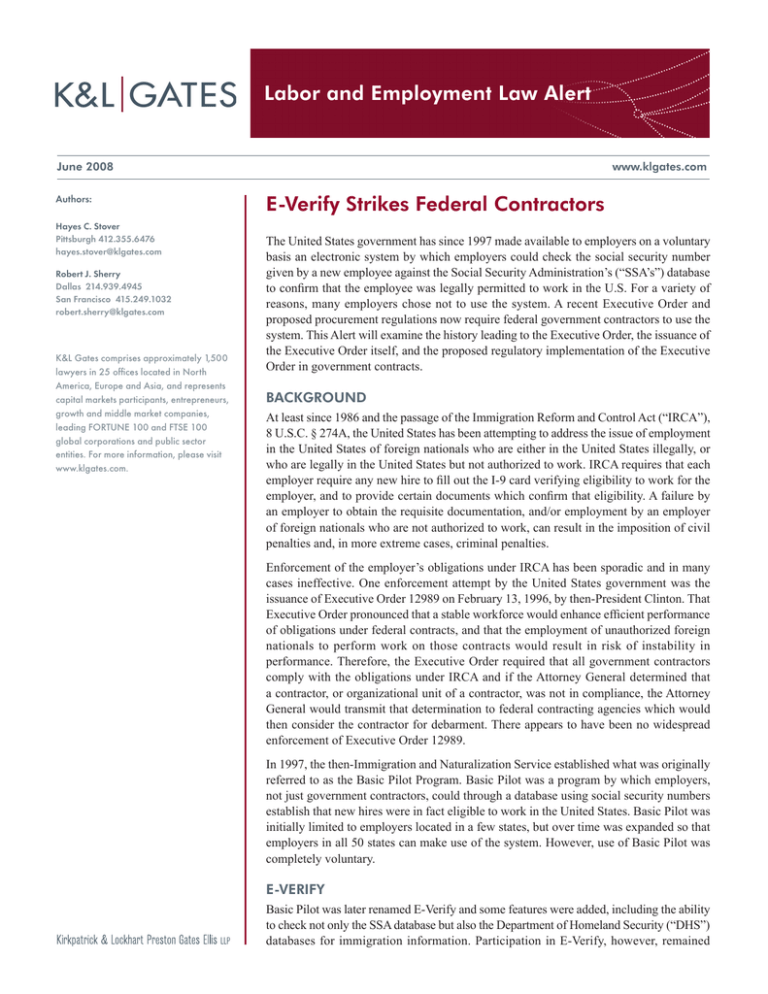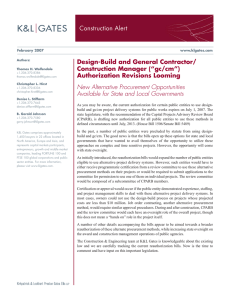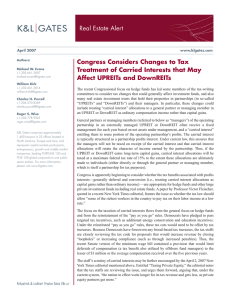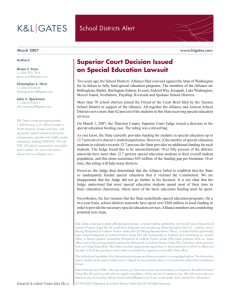
Labor and Employment Law Alert
June 2008
Authors:
Hayes C. Stover
Pittsburgh 412.355.6476
hayes.stover@klgates.com
Robert J. Sherry
Dallas 214.939.4945
San Francisco 415.249.1032
robert.sherry@klgates.com
K&L Gates comprises approximately 1,500
lawyers in 25 offices located in North
America, Europe and Asia, and represents
capital markets participants, entrepreneurs,
growth and middle market companies,
leading FORTUNE 100 and FTSE 100
global corporations and public sector
entities. For more information, please visit
www.klgates.com.
www.klgates.com
E-Verify Strikes Federal Contractors
The United States government has since 1997 made available to employers on a voluntary
basis an electronic system by which employers could check the social security number
given by a new employee against the Social Security Administration’s (“SSA’s”) database
to confirm that the employee was legally permitted to work in the U.S. For a variety of
reasons, many employers chose not to use the system. A recent Executive Order and
proposed procurement regulations now require federal government contractors to use the
system. This Alert will examine the history leading to the Executive Order, the issuance of
the Executive Order itself, and the proposed regulatory implementation of the Executive
Order in government contracts.
BACKGROUND
At least since 1986 and the passage of the Immigration Reform and Control Act (“IRCA”),
8 U.S.C. § 274A, the United States has been attempting to address the issue of employment
in the United States of foreign nationals who are either in the United States illegally, or
who are legally in the United States but not authorized to work. IRCA requires that each
employer require any new hire to fill out the I‑9 card verifying eligibility to work for the
employer, and to provide certain documents which confirm that eligibility. A failure by
an employer to obtain the requisite documentation, and/or employment by an employer
of foreign nationals who are not authorized to work, can result in the imposition of civil
penalties and, in more extreme cases, criminal penalties.
Enforcement of the employer’s obligations under IRCA has been sporadic and in many
cases ineffective. One enforcement attempt by the United States government was the
issuance of Executive Order 12989 on February 13, 1996, by then-President Clinton. That
Executive Order pronounced that a stable workforce would enhance efficient performance
of obligations under federal contracts, and that the employment of unauthorized foreign
nationals to perform work on those contracts would result in risk of instability in
performance. Therefore, the Executive Order required that all government contractors
comply with the obligations under IRCA and if the Attorney General determined that
a contractor, or organizational unit of a contractor, was not in compliance, the Attorney
General would transmit that determination to federal contracting agencies which would
then consider the contractor for debarment. There appears to have been no widespread
enforcement of Executive Order 12989.
In 1997, the then-Immigration and Naturalization Service established what was originally
referred to as the Basic Pilot Program. Basic Pilot was a program by which employers,
not just government contractors, could through a database using social security numbers
establish that new hires were in fact eligible to work in the United States. Basic Pilot was
initially limited to employers located in a few states, but over time was expanded so that
employers in all 50 states can make use of the system. However, use of Basic Pilot was
completely voluntary.
E-VERIFY
Basic Pilot was later renamed E‑Verify and some features were added, including the ability
to check not only the SSA database but also the Department of Homeland Security (“DHS”)
databases for immigration information. Participation in E‑Verify, however, remained
Labor and Employment Law Alert
voluntary. Employers who choose to participate in
E‑Verify must sign a Memorandum of Understanding
(“MOU”) with DHS. Key provisions of the MOU
are:
1.
No cost to the employer to participate
2.
The employer must continue to follow the
I‑9 requirements
3.
Participation may be limited to specific
hiring sites
4.
Applicable only to new hires
5.
The social security number must be submitted
within 3 days of hire and only on line
6.
Employer may use only I‑9 list B documents
containing a photograph
7.
E‑Verify is operated by United States
Citizenship and Immigration Services
(“USCIS”) using SSA and DHS databases
8.
E‑Verify will confirm within 3 work days or
send a tentative non-confirmation
9.
Employer has 8 work days to resolve issue, and
then must terminate the employee or tell DHS
the employee will not be terminated
10. If employee contests the non-confirmation, the
employee has 10 work days to resolve with
SSA or DHS
11. Employer may be fined if the employer does
not terminate the employee
Further information about E‑Verify may be accessed
at http://www.uscis.gov/E-verify.
EXECUTIVE ORDER 33285
The latest effort by the United States Government
to enforce the prohibitions against the hiring
of unauthorized foreign nationals is Executive
Order 33285 issued on June 6, 2008, amending
Executive Order 12989.
This Executive Order was published in the Federal
Register on June 11, 2008 at 73 F.R. 33285. Executive
Order 12989 as amended now requires that all federal
government contractors use an electronic verification
system to confirm the work eligibility of their
employees. The Executive Order provides in part:
Sec. 5. (a) Executive departments and agencies
that enter into contracts shall require, as a
condition of each contract, that the contractor
agree to use an electronic employment
eligibility verification system designated by
the Secretary of Homeland Security to verify
the employment eligibility of: (i) all persons
hired during the contract term by the contractor
to perform employment duties within the
United States; and (ii) all persons assigned
by the contractor to perform work within the
United States on the Federal contract.
The Secretary of DHS and the Attorney General were
directed to establish and maintain such a system and
establish the terms of its use. On June 9, 2008, DHS
Secretary Chertoff designated E‑Verify as the system
that all contractors must use to be in compliance with
the Executive Order.
If a government contractor fails to use the electronic
verification system, the contractor is subject to a risk
of debarment from federal contracts. The Executive
Order directed various federal contracting agencies
to develop regulations for enforcing the amended
Executive Order.
PROPOSED ACQUISITION REGULATION
As some indication of how seriously the government
intends to enforce the use of E‑Verify by government
contractors, proposed revisions to the Federal
Acquisition Regulation were issued on June 12, 2008,
or within a week after the issuance of the Executive
Order. 73 F.R. 33374. The proposed regulations are
subject to a comment period ending on August 11,
2008. Once they become final, the regulations generally
would be applicable to contracts awarded after the final
effective date. However, contractors should expect that
some agencies may effect administrative modifications
to add E-Verify obligations to existing contracts.
For example, the proposed regulation suggests that
E-Verify obligations will be added by amendment to
many indefinite-delivery indefinite-quantity (“ID IQ”)
contracts with the prospect for substantial remaining
performance efforts. In addition, as proposed, the
regulations would:
1.
Require the insertion of a clause mandating
E-Verify participation by the contractor in all
prime contracts for services or construction,
so long as the contract value exceeds the
generally applicable micro-purchase threshold
(currently $3,000), and the contracts are to be
performed in any part within the United States.
June 2008 | 2
Labor and Employment Law Alert
2.
Require insertion of the clause in all
contracts for materials unless they are for
(a) commercially available off-the-shelf
(“COTS”) items, or COTS items with minor
modifications; (b) under the micro-purchase
threshold; or (c) are to be performed entirely
outside the United States.
3.
Require inclusion of the clause in all
subcontracts over $3,000 for services or
construction if those subcontracts are to be
performed in any part within the United States.
4.
Require the contractor or subcontractor to
enroll in the E‑Verify program within 30
calendar days of award of any covered contract
and, within 30 calendar days thereafter, to
verify the eligibility of current employees hired
after November 6, 1986, who are assigned to a
covered contract or subcontract.
5.
6.
Require that if the contractor or subcontractor
is already enrolled in E‑Verify, to verify the
eligibility of current employees hired after
November 6, 1986, and who are assigned to
covered contracts or subcontracts, within 30
days of award.
7.
Allow the head of the contractor activity
to waive the requirement in exceptional
circumstances.
A new MOU reflecting provisions specific to
government contractors will be published. The biggest
differences between the application of E‑Verify to
government contractors and to other employers are
(1) the mandatory nature of participation and (2) that
a government contractor must sign up for all locations,
not just for locations selected by the employer. Thus,
the reach of the E-Verify obligations, for many
contractors and subcontractors, will extend well
beyond the locations at which contracts or subcontracts
are performed.
The government estimates that 168,000 employers
will register with E‑Verify pursuant to the new rules,
as contrasted with an estimated 70,000 employers
currently participating. In the first year, 3.8 million
employees will go through E‑Verify.
K&L Gates will continue to monitor the status of the
proposed regulations and provide further Alerts as
appropriate.
Require that following the initial period,
verify all new hires, not only those assigned
to covered contracts or subcontracts, and
any current employees hired after November
6, 1986 that are newly assigned to a covered
contract or subcontract, within 3 calendar days
of hire or assignment.
K&L Gates comprises approximately 1,500 lawyers in 25 offices located in North America, Europe and Asia, and represents capital markets
participants, entrepreneurs, growth and middle market companies, leading FORTUNE 100 and FTSE 100 global corporations and public sector
entities. For more information, visit www.klgates.com.
K&L Gates comprises multiple affiliated partnerships: a limited liability partnership with the full name Kirkpatrick & Lockhart Preston Gates Ellis LLP
qualified in Delaware and maintaining offices throughout the U.S., in Berlin, in Beijing (Kirkpatrick & Lockhart Preston Gates Ellis LLP Beijing
Representative Office), and in Shanghai (Kirkpatrick & Lockhart Preston Gates Ellis LLP Shanghai Representative Office); a limited liability partnership
(also named Kirkpatrick & Lockhart Preston Gates Ellis LLP) incorporated in England and maintaining our London and Paris offices; a Taiwan general
partnership (Kirkpatrick & Lockhart Preston Gates Ellis) which practices from our Taipei office; and a Hong Kong general partnership (Kirkpatrick &
Lockhart Preston Gates Ellis, Solicitors) which practices from our Hong Kong office. K&L Gates maintains appropriate registrations in the jurisdictions
in which its offices are located. A list of the partners in each entity is available for inspection at any K&L Gates office.
This publication/newsletter is for informational purposes and does not contain or convey legal advice. The information herein should not be used or
relied upon in regard to any particular facts or circumstances without first consulting a lawyer.
Data Protection Act 1998—We may contact you from time to time with information on Kirkpatrick & Lockhart Preston Gates Ellis LLP seminars and
with our regular newsletters, which may be of interest to you. We will not provide your details to any third parties. Please e-mail london@klgates.
com if you would prefer not to receive this information.
©1996-2008 Kirkpatrick & Lockhart Preston Gates Ellis LLP. All Rights Reserved.
June 2008 | 3






